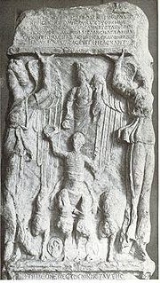
Porphyrius the Charioteer
Encyclopedia
Porphyrius the Charioteer (also known as Calliopas) was a renowned Roman charioteer
in the 5th and 6th centuries AD. In the time of Porphyrius, Roman chariot-racing was at its height. Charioteers were celebrities, and Porphyrius is famous for having seven monuments built in his honor in the Hippodrome
. These monuments serve as a glimpse into the history of the time, and into the life of Porphyrius. The age of Porphyrius is often referred to as the age of the Byzantine Charioteer. The age of his death is not known, but he retired from chariot-racing in his late 50s or 60s.

in 480 AD, the son of a certain Calchas, Porphyrius was a very skilled and clever charioteer. He was described as a handsome youth, so handsome that even a goddess might fall in love with him. He had seven monuments built throughout his lifetime to honor him as a charioteer and a warrior. The statues/monuments contain several inscriptions which contain a myriad of information on Porphyrius; ranging from his physical appearance to the honours received him by the emperor to his success as a warrior. A great deal of the story of Porphyrius, and his history, is collected from these statues. They are described in detail by a selection of epigrams from the Greek anthology
, and by The Chronicle of John Malalas
.
in Constantinople; he won his highest honors there.
Given Porphyrius' great skill and ability to win, each team would cater to Porphyrius to ensure that he would race with their color. It is also noted that Porphyrius had monuments built in his honor by both the Greens and the Blues, testimony to the fact that he was admired and sought after for his great chariot skills.
At the age of approximately 27, Porphyrius led the Greens to Antioch and attacked a synagogue in the suburb of Daphne, slaughtering many worshippers. This illustrates the violent methods practiced by Porphyrius when he was upset or displeased. His stature and fame gave him the leverage and ability to commit such atrocities.
Another event in his life was the suppression of Vitalian’s Revolt
in 515.
At the age of approximately 35, Porphyrius helped suppress the Vitalian Revolt by supporting Anastasius
.
, appears as a chauffeur in Robert Olen Butler
's 2009 novel, Hell. The nature of his infernal punishment is that the streets of Hell
are so crowded that he can never get the car out of first gear.
Chariot racing
Chariot racing was one of the most popular ancient Greek, Roman and Byzantine sports. Chariot racing was often dangerous to both driver and horse as they frequently suffered serious injury and even death, but generated strong spectator enthusiasm...
in the 5th and 6th centuries AD. In the time of Porphyrius, Roman chariot-racing was at its height. Charioteers were celebrities, and Porphyrius is famous for having seven monuments built in his honor in the Hippodrome
Hippodrome
A hippodrome was a Greek stadium for horse racing and chariot racing. The name is derived from the Greek words "hippos and "dromos"...
. These monuments serve as a glimpse into the history of the time, and into the life of Porphyrius. The age of Porphyrius is often referred to as the age of the Byzantine Charioteer. The age of his death is not known, but he retired from chariot-racing in his late 50s or 60s.

General information
Born in LibyaCyrenaica
Cyrenaica is the eastern coastal region of Libya.Also known as Pentapolis in antiquity, it was part of the Creta et Cyrenaica province during the Roman period, later divided in Libia Pentapolis and Libia Sicca...
in 480 AD, the son of a certain Calchas, Porphyrius was a very skilled and clever charioteer. He was described as a handsome youth, so handsome that even a goddess might fall in love with him. He had seven monuments built throughout his lifetime to honor him as a charioteer and a warrior. The statues/monuments contain several inscriptions which contain a myriad of information on Porphyrius; ranging from his physical appearance to the honours received him by the emperor to his success as a warrior. A great deal of the story of Porphyrius, and his history, is collected from these statues. They are described in detail by a selection of epigrams from the Greek anthology
Greek Anthology
The Greek Anthology is a collection of poems, mostly epigrams, that span the classical and Byzantine periods of Greek literature...
, and by The Chronicle of John Malalas
John Malalas
John Malalas or Ioannes Malalas was a Greek chronicler from Antioch. Malalas is probably a Syriac word for "rhetor", "orator"; it is first applied to him by John of Damascus .-Life:Malalas was educated in Antioch, and probably was a jurist there, but moved to...
.
A Great Charioteer
Although his precise age is not known, Porphyrius was described as a mature youth, as a youngish man, and as a youth with the first down on his cheeks. Porphyrius was unique in that, at a young age, he was not only victorious in his many races, but he was the youngest charioteer to have a monument built honoring him. Traditionally a charioteer would have a statue built after his retirement (usually in one's mid-40s-50s); Porphyrius was an exception. Porphyrius was the best charioteer of his time. He was the only charioteer to win the diversium twice in one day. The diversium was an honor given to one who would win the chariot race as a member of one team (Blues), and would then win again except that he would be racing as a member of the losing team (the Greens). To win the diversium, one would have to win as a member of the Blues, and then win against the Blues as a member of the Greens. Porphyrius did this twice in one day. He was very well known for his cleverness and ability to win with whatever he had. This is illustrated by his ability to win races regardless of the team that he was on. His most notable chariot-racing accomplishments were in the HippodromeHippodrome
A hippodrome was a Greek stadium for horse racing and chariot racing. The name is derived from the Greek words "hippos and "dromos"...
in Constantinople; he won his highest honors there.
Given Porphyrius' great skill and ability to win, each team would cater to Porphyrius to ensure that he would race with their color. It is also noted that Porphyrius had monuments built in his honor by both the Greens and the Blues, testimony to the fact that he was admired and sought after for his great chariot skills.
Antioch Pogrom (507) & Vitalian's Revolt (515)
Although Porphyrius was often given the celebrity treatment, he was not always the recipient of praise. He lost some of his popularity, especially from the Blues of Antioch, after the atrocities he committed there. The Antioch Pogrom in 507 is one of the two major events in Porphyrius' lifetime.At the age of approximately 27, Porphyrius led the Greens to Antioch and attacked a synagogue in the suburb of Daphne, slaughtering many worshippers. This illustrates the violent methods practiced by Porphyrius when he was upset or displeased. His stature and fame gave him the leverage and ability to commit such atrocities.
Another event in his life was the suppression of Vitalian’s Revolt
Vitalian (general)
Vitalian was an East Roman general. Rebelling in 513 against Emperor Anastasius I, he won over large parts of the army and people of Thrace. Successive rapprochements with Anastasius failed, and the revolt continued until it was finally defeated in 515. Vitalian then went into hiding until...
in 515.
At the age of approximately 35, Porphyrius helped suppress the Vitalian Revolt by supporting Anastasius
Anastasius I (emperor)
Anastasius I was Byzantine Emperor from 491 to 518. During his reign the Roman eastern frontier underwent extensive re-fortification, including the construction of Dara, a stronghold intended to counter the Persian fortress of Nisibis....
.
In popular culture
Porphyrius, driving a 1932 DuesenbergDuesenberg
Duesenberg was an Auburn, Indiana based American luxury automobile company active in various forms from 1913 to 1937, most famous for its high-quality passenger cars and record-breaking racing cars.-History:...
, appears as a chauffeur in Robert Olen Butler
Robert Olen Butler
Robert Olen Butler is an American fiction writer. His short-story collection A Good Scent from a Strange Mountain was awarded the Pulitzer Prize for fiction in 1993.-Early life:...
's 2009 novel, Hell. The nature of his infernal punishment is that the streets of Hell
Hell
In many religious traditions, a hell is a place of suffering and punishment in the afterlife. Religions with a linear divine history often depict hells as endless. Religions with a cyclic history often depict a hell as an intermediary period between incarnations...
are so crowded that he can never get the car out of first gear.

